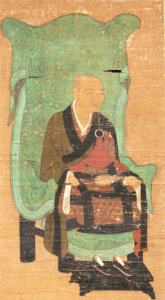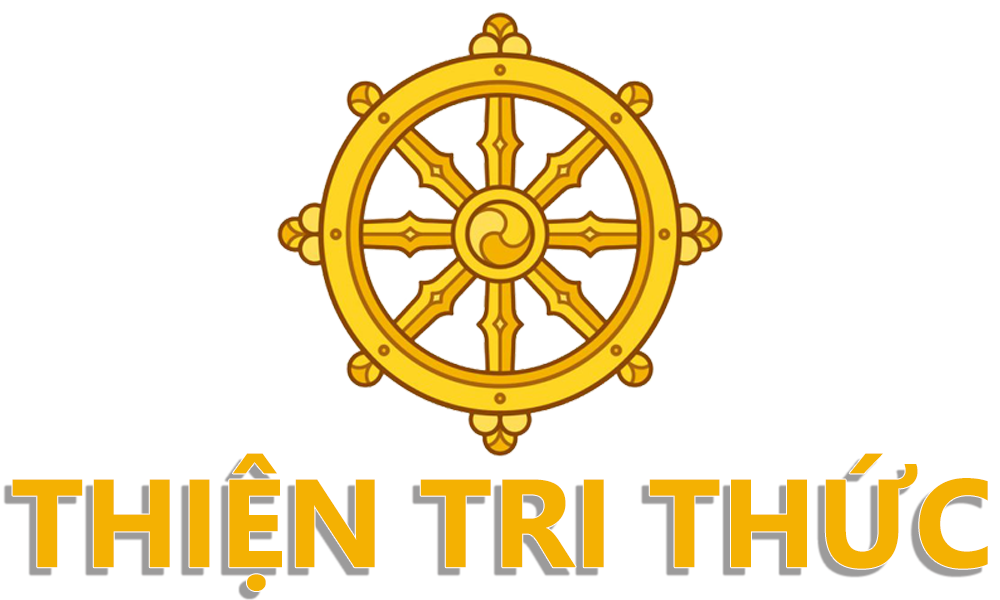SHARE:
DIRECTLY REVEALING THE TRUE SOURCE
(The true teaching of the ultimate meaning of the Buddha.) 
The Teaching of the One Vehicle That Reveals the Nature holds that all sentient beings without exception have the intrinsically enlightened, true mind. From [time] without beginning it is permanently abiding and immaculate. It is shining, unobscured, clear and bright ever- present awareness. It is also called the Buddha- nature and it is also called the tathāgatagarbha. From time without beginning deluded thoughts cover it, and [sentient beings] by themselves are not aware of it. Because they only recognize their inferior qualities, they become indulgently attached, enmeshed in karma, and experience the suffering of birth- and- death. The great enlightened one took pity upon them and taught that everything without exception is empty. He further revealed that the purity of the numinous enlightened true mind is wholly identical with all Buddhas.
Therefore the Hua- yen S ū tra says: “Oh sons of the Buddha, there is not a single sentient being that is not fully endowed with the wisdom of the Tathāgata. It is only on account of their deluded thinking and attachments that they do not succeed in realizing it. When they become free from deluded thinking, the all‐ comprehending wisdom, the spontaneous wisdom, and the unobstructed wisdom will then be manifest before them.” [The sūtra] then offers the analogy of a single speck of dust containing a sūtra roll [as vast as] the great chiliocosm. The speck of dust represents sentient beings, and the sūtra represents the wisdom of the Buddha. [The Hua- yen S ū tra ] then goes on to say: “At that time the Tathāgata with his unobstructed pure eye of wisdom universally beheld all sentient beings throughout the universe and said: ‘How amazing! How amazing! How can it be that these sentient beings are fully endowed with the wisdom of the Tathāgata and yet, being ignorant and confused, do not know it and do not see it? I must teach them the noble path enabling them to be forever free from deluded thinking and to achieve for themselves the seeing of the broad and vast wisdom of the Tathāgata within themselves and so be no different from the Buddhas.
[I will now] elaborate on [this teaching]. Because for numerous kalpas we have not encountered the true teaching, we have not known how to turn back and find the [true] origin of our.bodily existence but have just clung to illusory phenomenal appearances, heedlessly recognizing [only] our unenlightened nature, being born sometimes as an animal and sometimes as a human. When we now seek our origin in terms of the consummate teaching, we will immediately realize that from the very outset we are the Buddha. Therefore, we should base our actions on the Buddha’s action and identify our minds with Buddha’s mind, return to the origin and revert to the source, and cut off our residue of ignorance, reducing it and further reducing it until we have reached the [state of being] unconditioned. Then our activity in response [to other beings] will naturally be [as manifold as] the sands of the Ganges— that is called Buddhahood. You should realize that delusion and enlightenment alike are [manifestations of] the one true mind. How great the marvelous gate! Our inquiry into the origin of humanity has here come to an end.
(In the Buddha’s preaching of the previous five teachings, some are gradual and some are sudden. In the case of [sentient beings of] medium and inferior capacity, [the Buddha] proceeded from the superficial to the profound, gradually leading them forward. He would initially expound the first teaching [of Humans and Gods], enabling them to be free from evil and to abide in virtue; he would then expound the second and third [teachings of the Lesser Vehicle and the Phenomenal Appearances of the Dharmas], enabling them to be free from impurity and to abide in purity; he would finally discuss the fourth and fifth [teachings], those that Refute Phenomenal Appearances and Reveal the Nature, subsuming the provisional into the true, [enabling them] to cultivate virtue in reliance on the ultimate teaching until they finally attain Buddhahood. In the case of [sentient beings of] wisdom of the highest caliber, [the Buddha] proceeded from the root to the branch. That is to say, from the start he straightaway relied on the fifth teaching to point directly to the essence of the one true mind. When the essence of the mind had been revealed, [these sentient beings] themselves realized that everything without exception is illusory and fundamentally empty and tranquil; that it is only because of delusion that [such illusory appearances] arise in dependence upon the true [nature]; and that it is [thus] necessary to cut off evil and cultivate virtue by means of the insight of having awakened to the true, and to put an end to the false and return to the true by cultivating virtue. When the false is completely exhausted and the true is present in totality, that is called the dharmakāya Buddha.)
圭峰宗密 Guifeng Zongmi (780–841)
Guifeng Zongmi was a Tang dynasty Buddhist scholar-monk, installed as fifth patriarch of the 華嚴 Huayan (Japanese: Kegon; Sanskrit: Avatamsaka) school as well as a patriarch of the Heze lineage of Southern Chan.
Peter N. Gregory
TRỰC TIẾP PHÁT HIỆN NGUỒN GỐC THẬT
(Giáo lý chân chính về ý nghĩa tối hậu của Đức Phật.)
Giáo lý của Nhất thừa Hiển hiện bản chất cho rằng tất cả chúng sinh không có ngoại lệ đều có chân tâm giác ngộ vốn có. Từ [thời gian] vô thủy, nó thường trụ và vô nhiễm. Nó là sự sáng ngời, không bị che khuất, trong trẻo và sáng suốt luôn hiện hữu. Nó cũng được gọi là Phật tính và nó cũng được gọi là Như Lai Tạng. Từ thời gian vô thủy, những suy nghĩ mê lầm bao phủ nó, và [chúng sinh] tự mình không nhận thức được nó. Bởi vì họ chỉ nhận ra những phẩm chất thấp kém của mình, họ trở nên đắm chìm, vướng mắc trong nghiệp và trải qua nỗi đau khổ của sinh tử. Đấng giác ngộ vĩ đại đã thương hại họ và dạy rằng mọi thứ không có ngoại lệ đều là trống rỗng. Ngài còn tiết lộ thêm rằng sự thanh tịnh của chân tâm giác ngộ linh thiêng hoàn toàn giống hệt với tất cả các vị Phật.
Do đó, Kinh Hoa Nghiêm nói: “Hỡi các con của Đức Phật, không có một chúng sinh nào không được ban cho đầy đủ trí tuệ của Như Lai. Chỉ vì suy nghĩ mê lầm và chấp trước của họ mà họ không thành công trong việc chứng ngộ nó. Khi họ thoát khỏi suy nghĩ mê lầm, trí tuệ toàn tri, trí tuệ tự nhiên và trí tuệ không bị cản trở khi đó sẽ hiển lộ trước mặt họ.” [Kinh] sau đó đưa ra phép ẩn dụ về một hạt bụi duy nhất chứa một cuộn kinh [bao la như] đại thiên thế giới. Hạt bụi tượng trưng cho chúng sinh, và kinh tượng trưng cho trí tuệ của Đức Phật. ] [Kinh Hoa Nghiêm] sau đó nói tiếp: “Vào thời điểm đó, Như Lai với con mắt trí tuệ thanh tịnh không bị cản trở của mình, khắp nơi nhìn thấy tất cả chúng sinh trong khắp vũ trụ và nói: ‘Thật kỳ diệu! Thật kỳ diệu! Làm sao có thể là những chúng sinh này được ban tặng đầy đủ trí tuệ của Như Lai nhưng lại vô minh và mê lầm, không biết và không thấy được? Tôi phải dạy họ con đường cao quý giúp họ mãi mãi thoát khỏi suy nghĩ mê lầm và đạt được cho chính họ sự thấy được trí tuệ rộng lớn và bao la của Như Lai bên trong chính họ và do đó không khác gì chư Phật.”
[Bây giờ tôi sẽ] giải thích thêm về [giáo lý này]. Bởi vì trong vô số kiếp chúng ta đã không gặp được giáo lý chân chính, chúng ta đã không biết cách quay lại và tìm ra nguồn gốc [chân chính] của chúng ta.圭峰宗密 Quế Phong Tông Mật (780–841)
Quý Phong Tông Mật là một học giả-nhà sư Phật giáo thời nhà Đường, được bổ nhiệm làm tổ sư thứ năm của tông phái Hoa Nghiêm (華嚴, tiếng Nhật: Kegon; tiếng Phạn: Avatamsaka) cũng như là tổ sư của dòng thiền Nam tông Heze.
Bản dịch: Peter N. Gregory
SHARE:

Ban biên tập website Thiện Tri Thức chúng tôi chân thành cám ơn các trang mạng, các tác giả cùng những cộng tác viên , các bạn đọc đã cho phép chúng tôi trích đăng và gửi bài tới trang nhà chúng tôi. Những ý kiến đóng góp và bài viết xin gửi về email [email protected].
Mong mọi sự tốt lành!
© Bản quyền 2021 THIỆN TRI THỨC | Thiết kế bởi TIGONSYS